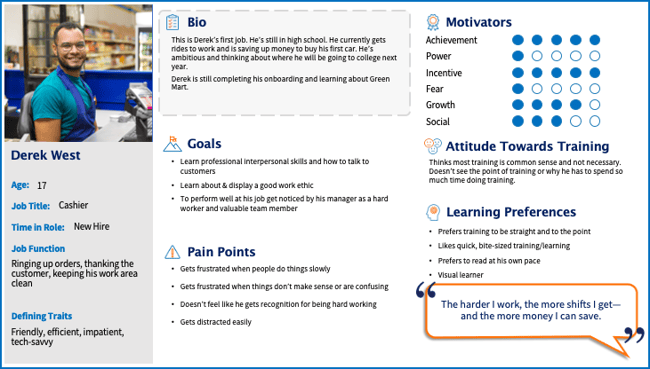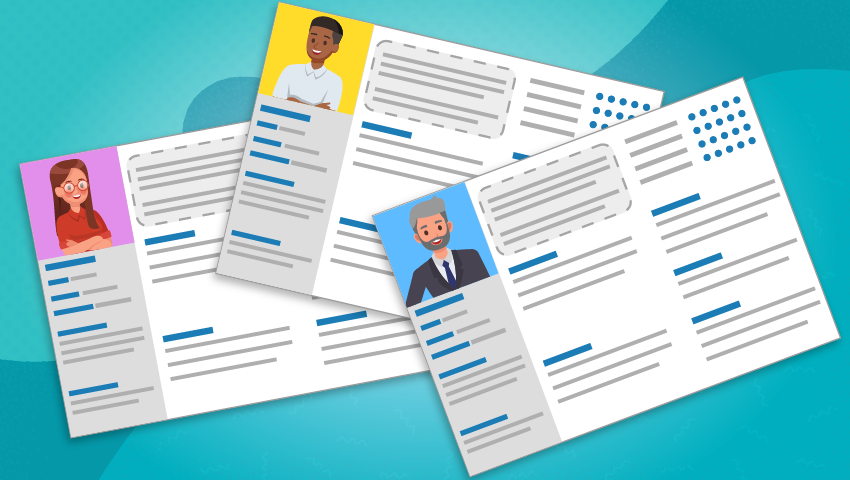In our first blog on Learner Personas, you learned all about the best practices for creating personas to use in your training projects. After gathering all of your audience data, talking with learners, analyzing goals and learner needs; you’ve expertly packaged up your data into an exceptional learner persona. You’ve even shown your fellow instructional designers and they’ve applauded your amazing achievement. But, what’s next? Don’t just file away your masterpiece into a drawer to be forgotten about while your training project goes through rounds of development and revision!
Your learner persona should be used to guide your project at every stage of development, informing not only the initial strategy and format but also substantiating decisions that are being made along the way. Here are some ways that your personas can be referenced and utilized throughout your entire project lifecycle to make sure your training hits the mark.
Making Introductions
Before you start any work on your project, the best thing to do is get everyone acquainted. We like to hold a Meet & Greet with everyone on the project team—including our writers, instructional designers, developers, and even our quality assurance experts—so that everyone can meet our personas. Walk through the personas just like you would as if you were introducing an actual learner. Refer to them by name and talk about their goals, pain points, and background as if they were the experiences of a real person. This is an important part of not only familiarizing your team with the learners that you’re creating the training for but also developing a sense of empathy and advocacy on your team.

Creating Your Initial Strategy
When trying to decide what approach or delivery method would be best for your training, take a look at your personas for guidance. Look at how you can solve pain points or help learners achieve goals through different strategies and pay attention to any data you’ve collected about how your personas respond to different types of trainings. Oftentimes, there won’t be a one-size-fits-all solution; so it can be useful to use a matrix to determine which strategies satisfy the most needs across all of your personas.
Designing & Writing
Learner Personas are a great reference for writers and instructional designers. Not only can it help you establish the tone and voice that you should use to connect with your learners, but it can help you read your writing from a different perspective. Does that technical jargon really make sense to Susan, your new hire who is only 2 weeks into her role? Is John, your 5-year tenured employee, going to get impatient during your five-minute intro while he waits for you to cut to the chase? Practice roleplaying and talking through your scripts with your different personas to help anticipate how your actual learners might react to your writing and material.
Personas can also help identify what material to include in the training. If you’ve ever had a Subject Matter Expert give you a 100 page binder and insist that every line contains critical information, you know that determining what the learners really need to know can be a matter of opinion. Use your personas to hone in on what your learners’ main needs are. This can help you focus on what will be most valuable to their learning experience instead of training on the whole kit and caboodle. (We’re not joking about those binders… but SMEs really are the unsung heroes of training. For advice on working with them, see our blog here.)
Building and Developing
When it comes time to develop or build your training, learner personas still have a role to play. Examine your user interface and any interactive elements through your learner personas. If any of your personas have difficulty with online training, does your interface take this into account and provide simple, straight forward navigation? If one of your personas is taking their training while out in the field on a phone or tablet, how will you take mobile design into account? Personas help us to think through functionality decisions and make a better informed choice with the learner in mind.
Testing and Evaluation
When you’re testing your training, this is a great time to see how what you’ve developed measures up against your learner personas. Ask yourself, “Does this interaction make sense knowing what we know about the persona? Does this content support my persona’s goals? Do they have other needs that we aren’t addressing?”
Using Learner Personas to Advocate for Your Projects
Your learner personas can even help you talk to stakeholders. After you’ve developed your personas, walk through them with your stakeholders. Involving your stakeholders, or at least keeping them in-the-know, can help them understand the value proposition of your training and the impact it will have. And the research that you’ve gathered by developing your personas can also help you address budgetary questions and make sure that you are investing in the right places.
Learner Personas aren’t meant to put away and forgotten. Referencing them throughout your project is critical to staying on track and making sure your project is a success. And the more you use them, the more natural it’ll be to advocate for them and by extension, your real learners.
Looking for advice on how to create your own persona? Check out our downloadable template!



